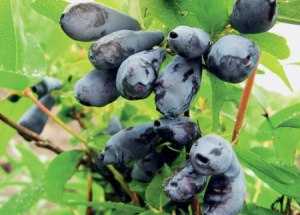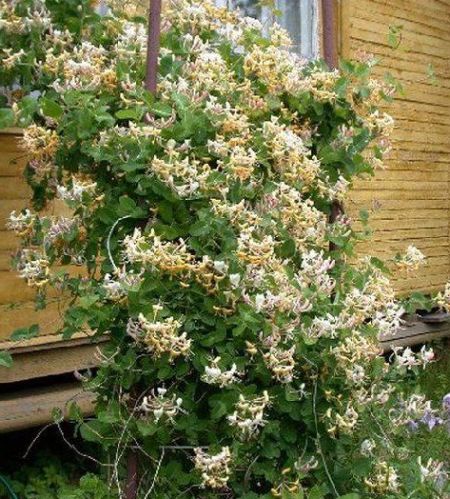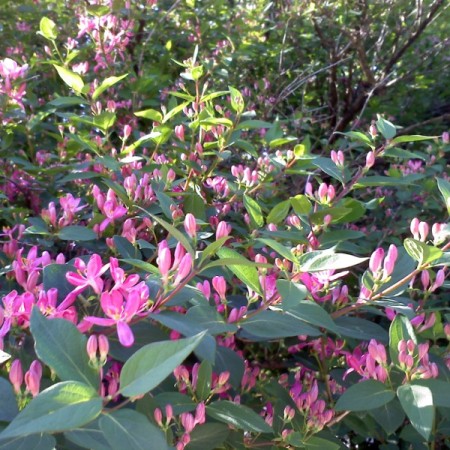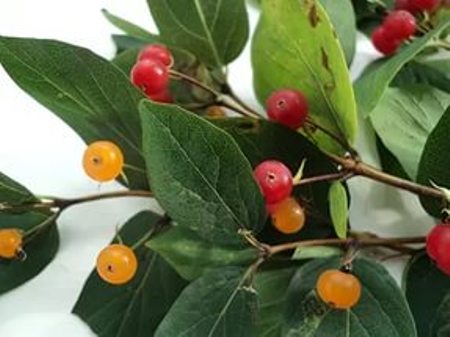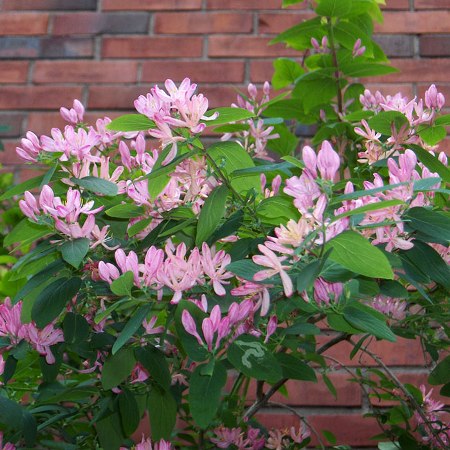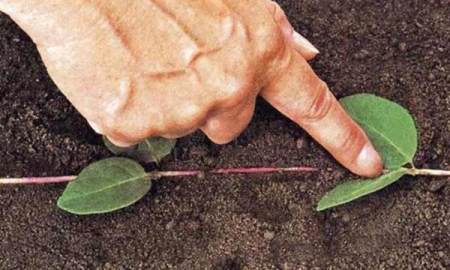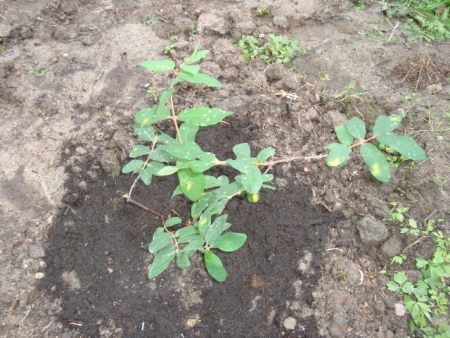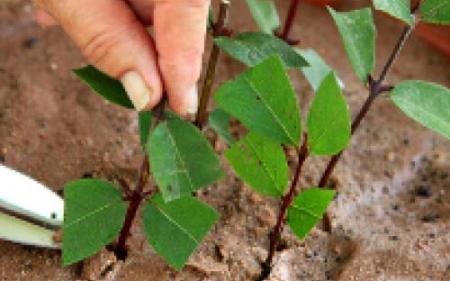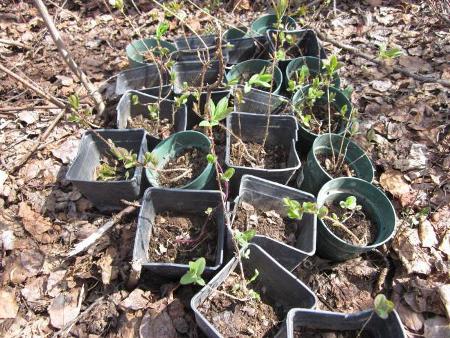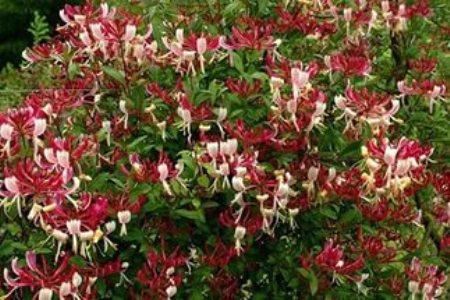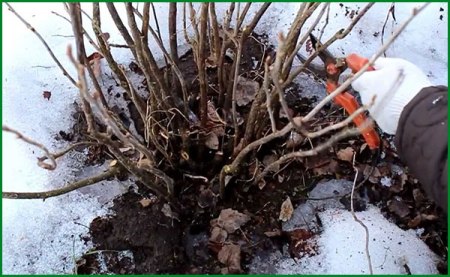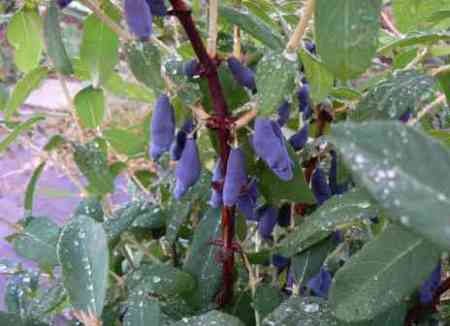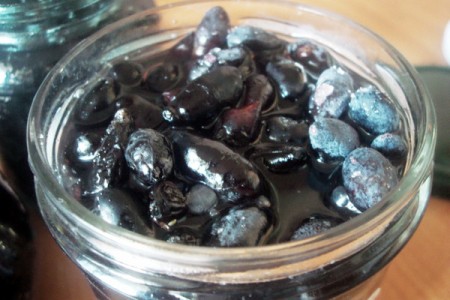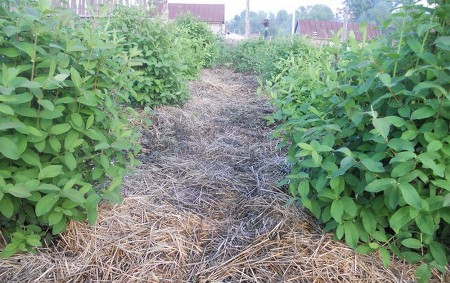This representative of the flora belongs to the genus of flowering lianas. Honeysuckle is often used by gardeners when landscaping the site, it is loved by designers in the landscape, because this plant helps to realize the rather intricate ideas.
Content
Honeysuckle caprylic - how attractive it is
Honeysuckle is the ideal plant for creating a hedge. It is planted next to the fences or around the gazebo, it creates a beautiful, vertical gardening. It is also worth noting that this genus of lianas, especially in the evening, serves as a source of pleasant and delicate aroma.
The period of flowering honeysuckle falls at the end of spring - early summer. At this time, branches are covered with tender yellow or gently pink flowers. Often, the outer part of the petals is the brightest. The shape of the flowers is similar to the shape of the orchid flowers.
At the end of the flowering process on the branches appear fruits - small red berries.
They serve as an additional ornament of the ornamental plant.
How to propagate honeysuckle honeysuckle, the characteristics of growing
The process of planting and care of honeysuckle is quite simple. In order to ensure the correct growth of the plant, there must be a support next to it, which, in the process of growth, the vine will twist and stretch upwards. The growth of the plant is limited only by the height of the nearby support.
Experienced gardeners have noticed that honeysuckle, according to average estimates, can grow up to one meter in length in a year.
the best time to disembark
Plant the plant in the open ground is better in the spring. In the transplant, the liana does not need it, it must be immediately landed in the place where its permanent stay is planned.
The soil before planting should be well moistened and loosened. Plant the liana's buds (it is from them that the honeysuckle grows), preferably several pieces (3 - 4) on one piece of the territory intended for planting. Such a landing option will give the opportunity to eventually get a more lush hedge.
Kneading can be done in two ways:
- the first - landing a kidney in a dug hole, the result - an adult plant in shape resembles a shrub;
- the second is the landing of the kidneys in the trench for planting, the result is a green honeysuckle.
choose a place for honeysuckle
Choosing a place for planting honeysuckle honeysuckle, attention should be stopped at the site to which have unimpeded access to sunlight.
The choice of this place will ensure the abundant flowering of the plant. Plant the plant in the shade, too, you can, but in this case the flowering process will be practically absent, and the stems will remain as strong and with lush foliage.
preparing the soil
As well as before planting any other plant, the soil before planting honeysuckle should be fertilized. For this purpose the following compounds are suitable:
- various mineral and organic microelements and fertilizers
- manure
- peat
If all the conditions of landing are carried out exactly with the recommendations, then at the end of spring - early summer you can observe the appearance of shoots. With good care, in the first year the plant can increase in growth by more than 1.5 meters.
how to feed seedlings
Further maintenance requires periodic feeding in the form of introducing the following fertilizers into the soil:
- potassium or nitrogen fertilizer
- two or three years of humus
- fertilizer from the overgrown vegetation.
If desired, fertilizer can be prepared by hand. To begin with, you need to select a location and place a compost pit on it. Then, over a period of time throw off the waste of vegetable origin, but do not forget to periodically make layers of peat. Approximately for a year it will turn out excellent peat compost.
Features of care for edible and decorative honeysuckle, fertilizing and watering:
care for honeysuckle
As already stated: leaving does not require special attention. The plant is not particularly susceptible to low temperatures and almost painlessly carries the temperature down to -40 degrees. In order to be sure one hundred percent that honeysuckle without problem will overwinter, it is better to cover it with lapnik.
If for some reason there are branches with signs of frostbite, with the advent of spring they are removed.
In the summer, especially a young plant, you need to water often and abundantly. An adult plant, for a certain amount of time, can do without watering.
The soil on which the liana grows requires periodic mulching. Mulching not only protects the soil and enriches it with useful substances, but also:
- will prevent the growth of weeds
- will retain moisture in the ground
- will allow less frequent resort to soil loosening
- reduces the likelihood of the entry and multiplication of pathogens at
- watering and rainfall
- in the summer, protect the top layer of the soil from overheating
- in the autumn and winter period will protect the soil from freezing, washing out and weathering.
Materials for mulching can be both inorganic origin (sand, small stones, gravel), and organic (leaves, grass, sawdust, straw).
honeysuckle winding, planting by cuttings
The easiest option for breeding honeysuckle is planting pre-germinated seeds. Another species of vine can be multiplied by layers or cuttings.
The process of reproduction with the help of cuttings can be produced both in spring, and at the end of autumn, and in summer. For cuttings in the fall will need healthy shoots of at least 10 centimeters long. Shoots should be with eyes, at least 5 pieces. The soil for planting should be prepared: loosen, moisturize well. Plant the stalk so that the upper eye is left above the ground. After planting, the area must be mulched with leaves.
Cuttings in the summer is better to spend then, when the plant will bloom. The length of the stem will help determine the internodes. On each stalk there should be two. Lower leaves should be cut off. The resulting cuttings are planted in a greenhouse. The greenhouse should be designed in such a way that the sun's rays do not penetrate it. Cuttings should be planted at a distance of 20 centimeters from each other. The rooting of the cut should be no more than 3 centimeters. The upper part of the hotbed should be made of glass. When a new leaf appears, the glass must be removed. Moistening of the soil with cuttings should occur several times a day.
In order for honeysuckle cuttings to overwinter, they must be mulched with peat. With the advent of spring, they can be safely planted in a place intended for permanent growth.
For reproduction by layers, it is necessary for the branches located in the lower part to deepen a little into the soil and produce abundant watering. This procedure is done in the spring. This will allow the plant, during the summer, to take root. After winter, the bushes formed will be strengthened and ready to be transplanted.
honeysuckle from seed
The independent process of growing a vine with seeds is quite long. Seed assembly should begin after the end of summer flowering. After assembly, the seeds are well washed and dried. Their storage should take place in a dry place. At the end of winter, they should be poured in moist sand and placed in a refrigerator.
Here they will be for two months. And only after the expiration of this period, they can be planted in the open ground. After disembarkation, you need to ensure that the soil was moistened and not covered with weeds. Transplantation to a permanent growth site can be done both in autumn and after the end of winter.
How to form a honeysuckle shrub decorative
In order for the plant to always attract attention and evoke positive emotions, its growth should not be allowed to run its course. If you run it, the presentable view disappears quickly enough, it will become formless.
In order for the liana to form correctly, a good support is needed. It should be strong and high. The material for the support can be diverse: wood, metal, a network of nylon and the like. Periodically, as you grow, the branches should be laid in the desired direction and try to distribute them evenly over the entire surface of the support.
pruning
To maintain the decorative qualities of the creeper, it must be cut in time and correctly. Thus the shape of the plant will always be neat. In addition to the form, periodic circumcision will give an impetus to the active release of buds and, as a consequence, abundant flowering.
Decorative lianas periodically discard the foliage located in the lower part of the stems. In order that this feature does not spoil the general appearance of gardening, you can plant other plants in close proximity to the roots of the vines, which will cover their bald stems with their green mass.
Honeysuckle Edible, Planting, Care, Reproduction
First of all it is worth noting that the fruits of edible honeysuckle are interesting for their own and unusual (as for berries) form and their exquisite taste. In addition, bright blue berries attract attention.
on the curative benefits of berries
Also worthy of attention is the fact that edible honeysuckle is famous for its useful and medicinal properties. Fruits recommend eating for people suffering from hypertension, diseases of the cardiovascular system, as well as with internal bleeding.
The use of berries helps to strengthen the walls of blood vessels, cleanse the gallbladder from sand and stones, helps to cope with poisonings and disorders of the gastrointestinal tract. Another positive quality is given to the berries of honeysuckle - it is an opportunity to lower the temperature for colds. To do this, the berries are ground with sugar and eat or use pre-prepared jam.
These berries are called unique not without thorough. They contain the most important for human biologically active vitamins and substances. These berries are recognized as leaders in the balanced content of vitamin C and P - active substances in them.
how to harvest correctly
There is one important nuance concerning berries - maturation occurs simultaneously and almost immediately the berries begin to crumble. Due to the fact that the skin of the fruit is too thin and delicate, when it falls from a certain height and strikes the soil, they deform and, as a result, quickly deteriorate. This reason does not make it possible to produce cultivation in industrial areas.
To prevent damage to the crop, under the bushes hang gauze or any other soft mesh. As soon as the berries began to ripen, the branches slightly shake. Berries fallen into a pendant are collected and packaged. But do not stack the whole crop in one container, it is better that each contained 2 -3 layers of fruit.
planting of honeysuckle edible
Plant bushes need at the end of summer or early autumn. Planting in the spring will delay fruiting for a year, even with good care. Experts recommend planting several and preferably several varieties at the same time. This recommendation is related to the fact that the plant belongs to the genus cross-pollinating. When planting only one bush, the expectation of the harvest can be eternal.
The most successful place for planting bushes is a spacious place with unhindered access to sunlight. Primer before planting should be fertilized and moistened well. In the pit dug for planting, you need to add a lot of peat and humus from the leaves. At the very bottom of the pit is to put waste from the garden and dried grass.
The distance between the pits should be approximately 1.5 meters. It is this kind of footage that will be ideal for dusting. After landing is over, each planted bush should be watered, at least 1 bucket of water.
Do not cut the branches of edible honeysuckle. The only thing that is needed - with the advent of spring to remove broken, withered or interfering branches.


